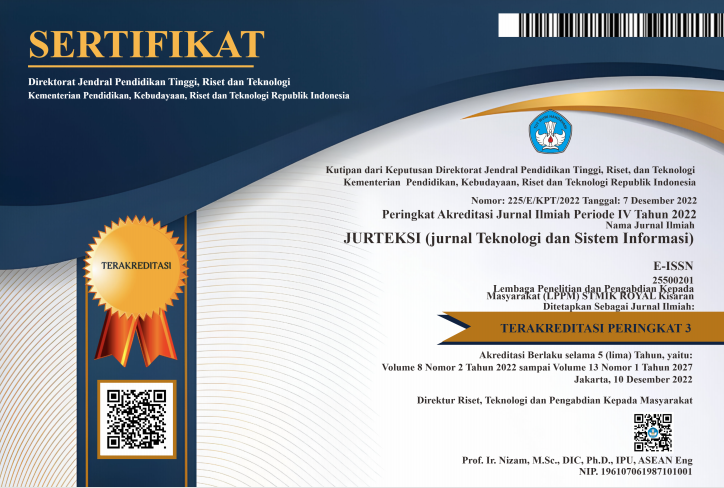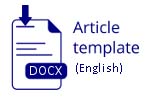APPLYING USER-CENTERED DESIGN FOR MOBILE APPLICATIONS INTERFACE DESIGN
Abstract
Abstract: The Healthy Food Supplier App, which introduces groundbreaking innovations to increase public access to and delivery of healthy food, has emerged as a new phenomenon in the food sector. This research intends to examine and describe how the use of healthy food suppliers contributes to improving public health by making healthy food accessible to obtain and deliver it quickly. The development of mobile applications with the aim of providing healthy food and ingredients for the community is the subject of this research. The aim of this app is to provide original responses to issues related to raising awareness of quality of life and the value of nutritious food in everyday life. The User Centered Design (UCD) method needs to be applied to categorize various user information needs and package them into a mobile application design model. The results of the application design showed that the interface design for the pioneer food and health food raw material application was successfully created using the implementation of the UCD method with a number of revisions that have been updated since the evaluation as one of the feature developments in the application. The food recording feature and personalized recommendations implemented in this mobile application provide users with awareness and guidance in adopting healthier eating patterns.
Keywords: Design Interface; Mobile Applications; Requirements Engineering; User-Centered Design
Abstrak: Aplikasi Pemasok Makanan Sehat yang memperkenalkan inovasi terobosan untuk meningkatkan akses publik ke dan pengiriman makanan sehat, telah muncul sebagai fenomena baru di sektor makanan. Penelitian ini bermaksud untuk mengkaji dan mendeskripsikan bagaimana penggunaan pemasok makanan sehat berkontribusi dalam peningkatan kesehatan masyarakat dengan membuat makanan sehat dapat diakses untuk mendapatkan dan mengantarkannya dengan cepat. Pengembangan aplikasi mobile dengan tujuan menyediakan makanan dan bahan makanan sehat bagi masyarakat menjadi pokok bahasan penelitian ini. Tujuan dari aplikasi ini adalah untuk memberikan tanggapan orisinal terhadap masalah yang terkait dengan peningkatan kesadaran kualitas hidup dan nilai makanan bergizi dalam kehidupan sehari-hari. Metode User Centered Design (UCD) perlu diterapkan untuk mengkategorikan berbagai kebutuhan informasi pengguna dan mengemasnya ke dalam model desain aplikasi mobile. Hasil perancangan aplikasi didapatkan bahwa desain antarmuka aplikasi pelopor makanan dan bahan baku makanan kesehatan berhasil dibuat dengan menggunakan implementasi metode UCD dengan sejumlah revisi yang sudah diperbarui sejak evaluasi sebagai salah satu pengembangan fitur pada aplikasi. Fitur pencatatan makanan dan rekomendasi personal yang diterapkan pada aplikasi mobile ini memberikan pengguna kesadaran dan panduan dalam mengadopsi pola makan yang lebih sehat.
Kata Kunci: Design Interface; Mobile Applications; Requirements Engineering; User-Centered Design
References
Rusliyawati, Suryani, Ardian. (2020). Rancang Bangun Identifikasi Kebutuhan Kalori Dengan Aplikasi Go Healthy Life. Jurnal Teknologi dan Sistem Informasi, Vol (1), 47 - 56.
Lumentut, N. R., Kaunang, S. T. G., & Sugiarso, B. (2023). Aplikasi Edukasi Gizi Seimbang untuk Pola Makan Sehat di Masa Pandemi Covid-19.
Fudholi, “Animasi interaktif pembelajaran pengenalan dan perancangan jaringan komputer,†vol. 3, no. 1, hal. 28–40, 2015.
Erry Yudhya Mulyani, S. M. (2020). Asupan Gizi dalam Upaya Meningkatkan Imunitas di Masa Pandemi Covid-19. Jurnal Kesehatan.
D. Dayton and S. Aklani, “ANALISIS DAN PENGEMBANGAN APLIKASI MOBILE DIET ARTIFICIAL INTELLIGENCE DENGAN PENDEKATAN CHALLENGE BASEDâ€, simika, vol. 6, no. 1, pp. 48-58, Feb. 2023.
West, Joshua H., Lindsay M. Belvedere, Rebecca Andreasen, Christine Frandsen, P. Cougar Hall, and Benjamin T. Crookston. "Controlling your “app†etite: how diet and nutrition-related mobile apps lead to behavior change." JMIR mHealth and uHealth 5, no. 7. 2017.
Samoggia A, Riedel B. Assessment of nutrition-focused mobile apps' influence on consumers' healthy food behaviour and nutrition knowledge. Food Research International. 2020.
Lim, S.Y., Lee, K.W., Seow, W.L., Mohamed, N.A., Devaraj, N.K. and Amin-Nordin, S., Effectiveness of integrated technology apps for supporting healthy food purchasing and consumption: A systematic review. Foods, 10(8), p.1861. 2021.
Franco, Rodrigo Zenun, Rosalind Fallaize, Julie A. Lovegrove, and Faustina Hwang. "Popular nutrition-related mobile apps: a feature assessment." JMIR mHealth and uHealth 4, no. 3 . 2016.
Kaligis, Dicky Larson, and Refyul Rey Fatri. "Pengembangan Tampilan Antarmuka Aplikasi Survei Berbasis Web Dengan Metode User Centered Design." JUST IT: Jurnal Sistem Informasi, Teknologi Informasi dan Komputer 10.2 (2020): 106-114.
Eugenia, Migunani Puspita, et al. "Pendekatan Metode User-Centered Design dan System Usability Scale dalam Redesain dan Evaluasi Antarmuka Website." Seminar Nasional Official Statistics. Vol. 2022. No. 1. 2022.
M. Ehn, M. Derneborg, Å. Revenäs, and A. Cicchetti, “User-centered requirements engineering to manage the fuzzy front-end of open innovation in e-health: A study on support systems for seniors’ physical activity,†Int J Med Inform, vol. 154, Oct. 2021, doi: 10.1016/j.ijmedinf.2021.104547.
A. Lopes, N. Valentim, B. Moraes, R. Zilse, and T. Conte, “Applying user-centered techniques to analyze and design a mobile application,†Journal of Software Engineering Research and Development, vol. 6, no. 1, Dec. 2018, doi: 10.1186/s40411-018-0049-1.
B. Xiao, K. Su, and X. Su, “A Requirement Engineering Approach to User-Centered Design,†in Journal of Physics: Conference Series, Institute of Physics Publishing, Mar. 2020. doi: 10.1088/1742-6596/1453/1/012032.
L. Teixeira, C. Ferreira, and B. S. Santos, “User-centered requirements engineering in health information systems: A study in the hemophilia field,†Comput Methods Programs Biomed, vol. 106, no. 3, pp. 160–174, Jun. 2012, doi: 10.1016/j.cmpb.2010.10.007.
A. Nurrifqhi, S. Widowati, and M. Imrona, “Implementasi User Centered Requirements Engineering pada Perancangan Aplikasi Panduan Informasi Pertanian untuk Petani,†Journal on Computing, vol. 4, no. 2, pp. 9–20, 2019, doi: 10.21108/indojc.2019.4.2.256.
D. Larson Kaligis and R. R. Fatri, “PENGEMBANGAN TAMPILAN ANTARMUKA APLIKASI SURVEI BERBASIS WEB DENGAN METODE USER CENTERED DESIGN,†2020. [Online]. Available: https://jurnal.umj.ac.id/index.php/just-it
A. P. Paskalis, H. Hidayati, S. Kom, and E. Darwiyanto, “Implementasi User Centered Design untuk Merancang Antarmuka Sistem Informasi Eksekutif pada PT Pos Indonesia,†2015.
D. A. Lestari, H. W. Utomo, and A. D. Septiadi, “Redesign Website Pariwisata Berbasis User Centered Design (UCD),†JURIKOM (Jurnal Riset Komputer), vol. 10, no. 2, p. 615, Apr. 2023, doi: 10.30865/jurikom.v10i2.6096.
Lubis, Rizky Fauziah. "Perancangan Antarmuka Aplikasi Berbasis Web Menggunakan User Centered Design Dalam Pembelajaran Keragaman Budaya." Jurteksi (Jurnal Teknologi dan Sistem Informasi) 4.1 (2017): 1-6.













